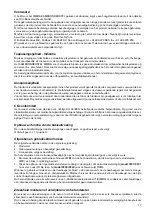
8
Preface
Thank you for selecting the KIMBA (PANDA) Indoor Chassis. Our engineers have designed the high-quality KIMBA
(PANDA) to make your life safer and easier, and we’ve included this manual to help you use and care for this dura-
ble Otto Bock product.
Please read the following instructions to make sure you use this product safely and for its recommended use. If you
have any further questions, or if you have any problems, please contact your specialist dealer. We hope that the KIMBA
(PANDA) meets your expectations and helps to improve your quality of life.
Indications
(Source: Catalogue of aids and list of aids for the health insurance funds, FRG)
It is obligatory for seat shells and seating systems to be equipped with chassis or sub-frames suitable for indoor and/
or outdoor use.
The aim is to provide disabled persons with mobility and transport.
The KIMBA (PANDA) INDOOR CHASSIS is intended for indoor use and has been specially developed to accept
orthopedic seating systems (e. g. seat shells). Its multiple adjustment facilities allow the sub-frame to be optimally
adapted to meet individual requirements.
It will be necessary for appropriate adjustments to be made to adapt the chassis to the desired seating system; this
work should only be carried out by a specialist in orthopedic or rehabilitation appliances.
Liability
The manufacturer’s warranty applies only if the device has been used under the conditions and for the purposes de-
scribed. The manufacturer recommends that the device be used and maintained according to the instructions for use.
The manufacturer is not responsible for damages caused by components and spare parts not approved by the ma-
nufacturer. Repairs must be carried out exclusively by authorised dealers or by the manufacturer.
CE Conformity
This device meets the requirements of the 93 / 42 / EEC guidelines for medical devices. This device has been classified
as a class I device according to the classification criteria outlined in appendix IX of the guidelines. The declaration of
conformity was therefore created by Otto Bock with sole responsibility according to appendix VII of the guidelines.
Set-up and use of basic versions
The references made in these instructions to graphics and items in the illustration section are to be read as follows:
(1/A) = Fig. No. 1 / item A
Unpacking and setting up
In the original package you will find the following components:
• Chassis
• User manual and tools required
• Accessories as ordered
After removing the transport safety snaps and the packaging material, please proceed as follows:
• Using the two screws
(2/D)
, screw the support unit to the base frame in such a way that the aperture for the
spring button
(2/C)
is on the left side with regard to travel direction.
• Now press th
e spr
ing button and slide the insert into the support unit tubing so that the tilt adjustment device is
pointing
•
forwards, in travel direction, for models 2231 / 2241 (1/A),
• to the rear,
against travel direction, for models 2233 / 2243 (1/B).
When using the pushbar, additionally screw the enclosed longer screws and distance pieces to the pushbar retainer
plate. Mount the pushbar retainer on the side of the base frame where the telescoping tubes are inserted.
After tightening all screw connections, a multi-functional seat unit (KIMBA) or, via an interface, an individually adjusted
seating shell can be mounted on the indoor chassis.
For descriptions as to this subject, please refer to the User Manual for the KIMBA Reha Stroller System.
Attaching seating shell to, and removing from, chassis
The seating shell can easily be removed from the chassis for transport or for if you need to divide the KimbaZUG’s
weight into two more manageable loads.
This is also convenient if the seating shell is used with both indoor and outdoor chassis, as the shell can be easily
Summary of Contents for KIMBA 2231
Page 2: ...1 A 2 C B A B C F E D...






































